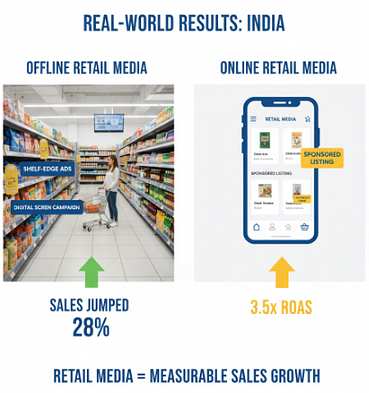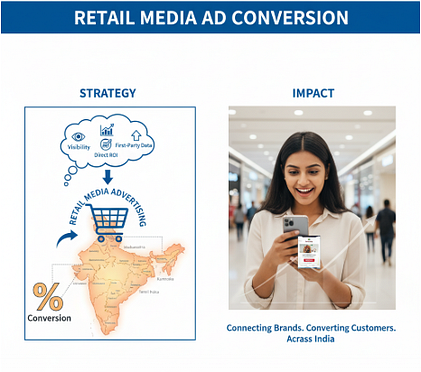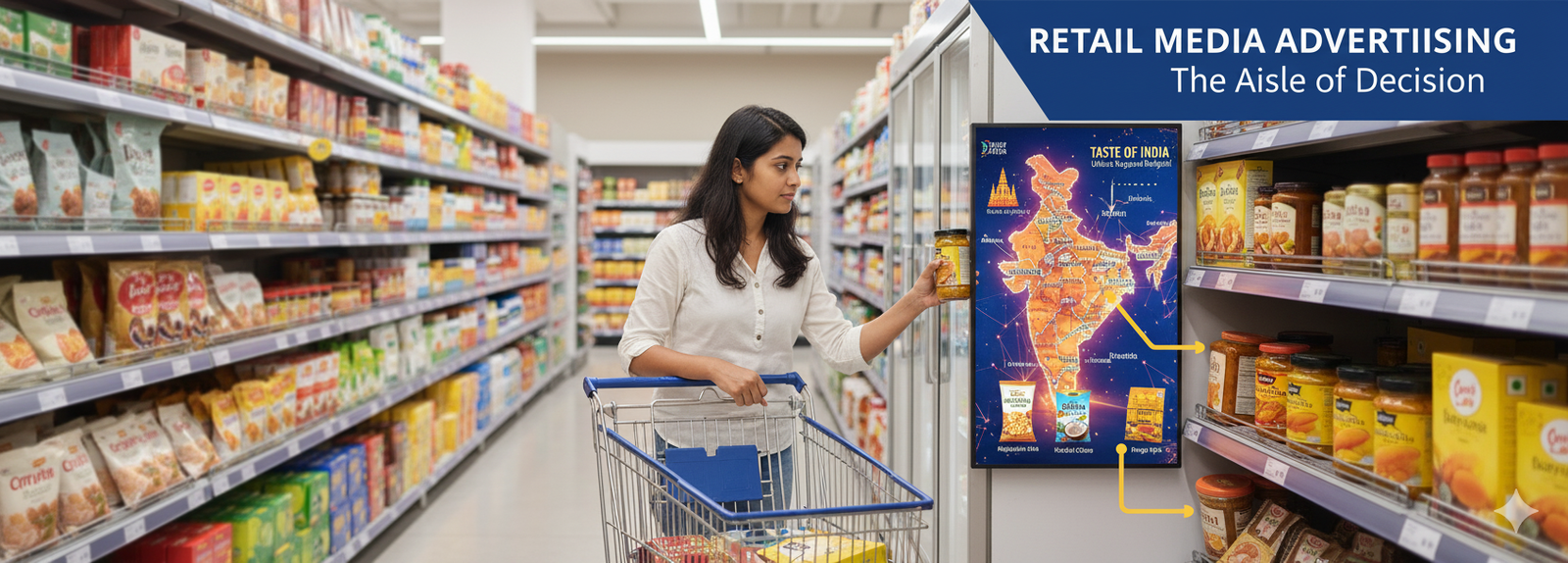How Retail Media is Redefining Brand Visibility and Conversions in a Shopper-First World
The Aisle Where Decisions Happen
Picture this: A shopper walks into a store intending to buy one product, but by the time they reach checkout, they’ve added three more items to their basket. Why? Because the right ad spoke to them at the right place, at the right time.
That’s the magic of Retail Media Advertising — a powerful channel that doesn’t just promote awareness but drives direct conversions at the point of purchase. In today’s digital-first yet shopper-driven market, retail media blends the best of precision targeting, contextual relevance, and measurable ROI.
This blog unpacks why Retail Media Advertising is one of the fastest-growing pillars of marketing and why businesses and marketers can’t afford to ignore it.
What is Retail Media Advertising?
Retail media advertising is the placement of ads within a retailer’s ecosystem — both online (e-commerce platforms, retailer apps, search pages) and offline (in-store displays, POSM, digital screens, end caps, shelf talkers).
Think of it as advertising inside the store’s world where shoppers are already in buying mode. Unlike traditional awareness-focused advertising, retail media captures consumers when they’re most likely to purchase.
Why Retail Media Advertising is a Game-Changer
Here’s why marketers globally are turning towards retail media:
- Proximity to Purchase Decisions — Ads appear at the exact moment shoppers decide what to buy.
- High Conversion Rates — Retail media ads often outperform traditional ads because they are contextual and intent-driven.
- Rich Shopper Data — Retailers have first-party shopper insights, enabling precise targeting.
- Measurable ROI — Every click, view, or purchase can be tracked against spend.
- Hyperlocal Impact — For physical retail, ads directly influence basket size and in-store navigation.
Storytelling: Imagine Your Brand Owning the Shelf

Imagine walking into a grocery store: your brand’s chips bag is highlighted at the shelf edge, a digital screen plays a crisp ad, and by the checkout counter, your product catches the shopper’s eye again.
Now translate that to e-commerce: a shopper searches for “snacks,” and your product appears at the top of sponsored listings, supported by a banner ad on the homepage.
That’s omnichannel retail media advertising in action — your brand literally owns the shelf, both online and offline.
Retail Media in Numbers (Proof of ROI)
- Global retail media ad spend is projected to cross $140 billion by 2026.
- Sponsored product ads on e-commerce platforms can deliver 3x higher ROAS (Return on Ad Spend) compared to traditional display ads.
- In-store retail media like digital signage can lift sales by 20–25% for promoted products.
Numbers don’t lie — retail media isn’t a “nice-to-have” anymore, it’s a must-have strategy.
The Strategic Value of Retail Media Advertising
1. Owning Shopper Attention at Critical Moments
Unlike social media ads that compete with endless scrolling, retail media captures undivided attention. Shoppers are already in “buying mode.”
2. Blending Digital Precision with Physical Impact
Retail media combines the measurability of digital ads with the physical dominance of in-store branding. It’s the perfect hybrid.
3. First-Party Data Advantage
As cookies phase out, retail media provides rich first-party data from retailers — gold for marketers looking to target smarter.
4. Cost-Effective, High ROI
Because it reaches shoppers at the bottom of the funnel, retail media can reduce wasted impressions and maximize ROI.
Formats of Retail Media Advertising
Retail media comes in different engaging formats:
- In-Store Media: Shelf displays, end caps, digital screens, floor graphics.
- E-Commerce Media: Sponsored search, display banners, category takeovers.
- Checkout Promotions: Ads at billing counters, both online and offline.
- Loyalty Programs & Apps: Targeted promotions via push notifications or rewards.
Each format ensures your brand meets the shopper at the decisive moment.

Real-World Example (Storytelling ROI)
A leading FMCG brand partnered with a retail chain to run shelf-edge ads and digital screen campaigns in 200 stores across India.
- Result? Sales jumped 28% in two months for the featured product.
- Online, the same brand ran sponsored listings on the retailer’s app, leading to a 3.5x ROAS.
This proves retail media doesn’t just raise awareness — it translates directly into measurable sales.
Fun Analogy: Retail Media is the “Shopkeeper Who Never Sleeps”
Think of retail media as that attentive shopkeeper who always knows how to convince you to try something new — except now, it’s powered by AI, digital screens, and shopper insights. It’s always on, always influencing, always selling.
How Businesses Can Leverage Retail Media
Here’s how marketers can maximize retail media advertising:
- Plan Omnichannel Campaigns — Combine in-store visibility with e-commerce ads.
- Leverage Shopper Data — Use retailer’s insights for precise targeting.
- Test & Optimize — Run A/B campaigns for formats like shelf talkers vs. digital signage.
- Focus on ROI Metrics — Track sales uplift, basket size, and repeat purchases.
- Build Long-Term Partnerships with Retailers — Consistency builds trust and loyalty.
The Future of Retail Media Advertising
- AI & Personalization — Expect hyper-personalized ads based on shopping history.
- AR & Interactive Screens — Try-on and try-out experiences in-store.
- Voice Commerce Ads — “Alexa, add coffee” integrated with retailer ecosystems.
- Programmatic Retail Media — Automated buying of retail ad space with precision.
The retail media space is evolving fast, and brands that adapt early will own the shopper’s journey.
Conclusion: Why Retail Media Should Be Your Next Big Move
In a world of banner blindness and ad fatigue, retail media advertising cuts through the noise by showing up exactly where it matters — the point of purchase.

For businesses and marketers, this is not just an ad strategy — it’s a conversion strategy. If you want to maximize visibility, leverage first-party data, and see direct ROI, retail media advertising is your best bet.
Call to Action
Ready to turn shopping aisles into your brand’s stage and checkout counters into conversion engines?
👉 Let’s craft a retail media advertising strategy that puts your brand directly in front of buyers, both online and offline.
FAQs on Retail Media Advertising
Q1. What is retail media advertising?
Retail media advertising is the promotion of products within a retailer’s ecosystem (online or offline) to influence shoppers at the point of purchase.
Q2. Why is retail media important for businesses?
It directly impacts buying decisions, boosts sales, and provides measurable ROI.
Q3. How does retail media advertising work in stores?
Through shelf displays, digital signage, checkout ads, and promotional zones inside the store.
Q4. How does retail media advertising work online?
Through sponsored search, display banners, category takeovers, and app notifications.
Q5. What are the key benefits of retail media advertising?
High conversions, first-party shopper data, measurable ROI, and hyperlocal reach.
Q6. Is retail media only for big brands?
No, even small and mid-sized businesses can leverage retail media with targeted campaigns.
Q7. How can retail media campaigns be measured?
By tracking ROAS, sales uplift, average basket size, and repeat purchase rates.
Q8. What is the future of retail media advertising?
AI-driven personalization, AR experiences, programmatic ad buying, and integration with voice commerce.

